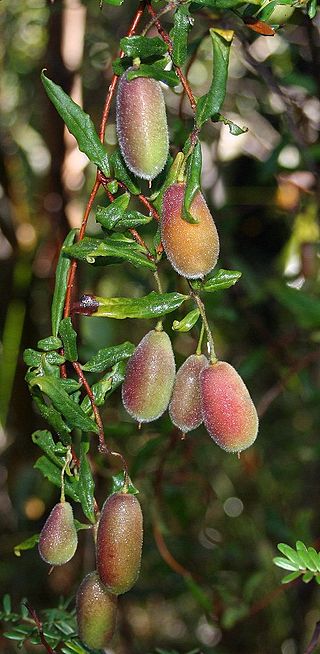
Billardiera, commonly known as appleberries, snot berries, or bluebell creepers, is a genus of flowering plants in the family, Pittosporaceae and is endemic to Australia. Plants in the genus Billardiera are woody scramblers, climbers or twiners with elliptic, lance-shaped or linear leaves arranged alternately along the stems, the flowers with petals that are joined to form a tube at the base with spreading lobes, and succulent or fleshy fruit.

Grevillea olivacea, commonly known as olive grevillea, is a species of flowering plant in the family Proteaceae and is endemic to the west coast of Western Australia. It is a dense, erect shrub with elliptic to egg-shaped leaves, and erect clusters of bright red and orange or yellow flowers with a red to yellow style.

Grevillea obtusifolia, commonly known as obtuse leaved grevillea, is a species of flowering plant in the family Proteaceae and is endemic to the south-west of Western Australia. It is a spreading to dense, prostrate shrub with oblong to narrowly elliptic leaves and clusters of eight to twelve, pink or red flowers.
Verticordia attenuata is a flowering plant in the myrtle family, Myrtaceae and is endemic to the south-west of Western Australia. It is a shrub with a single main stem, small leaves and pink to purple flowers which fade to white as they age. It usually grows in sand in areas that are wet in winter, often amongst grasses and is found in coastal areas near Bunbury.

Billardiera cymosa, commonly known as sweet apple-berry or love fruit, is a species of flowering plant in the family Pittosporaceae and is endemic to south-eastern continental Australia. It is usually a slender climber that has narrowly egg-shaped leaves and pale blue or pale purplish flowers arranged in groups of about five to twelve.
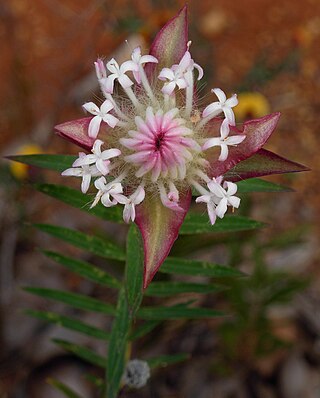
Pimelea spectabilis, or bunjong, is a species of flowering plant in the family Thymelaeaceae and is endemic to the south-west of Western Australia. It is an erect shrub with very narrowly elliptic leaves and heads of white, pale pink or pale yellow flowers surrounded by 4 or 6 egg-shaped involucral bracts.
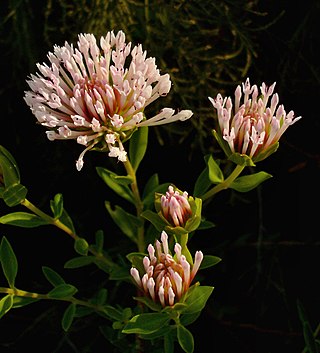
Pimelea calcicola is a species of flowering plant in the family Thymelaeaceae and is endemic to part of the west coast of Western Australia. It is an erect to spreading shrub with elliptic leaves arranged in opposite pairs, and head-like racemes of pale to deep pink, tube-shaped flowers surrounded by leaf-like involucral bracts.

Grevillea diversifolia, the variable-leaved grevillea, is a species of flowering plant in the family Proteaceae and is endemic to the south-west of Western Australia. It is an erect to prostrate shrub with simple or divided leaves and groups white to cream-coloured flowers with a dull red style.
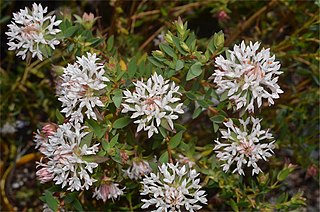
Pimelea sylvestris is a species of flowering plant in the family Thymelaeaceae and is endemic to the south-west of Western Australia. It is an erect shrub with narrowly elliptic to elliptic leaves arranged in opposite pairs, and compact heads of white or pink flowers surrounded by 2 or 4 pairs of narrowly egg-shaped involucral bracts.
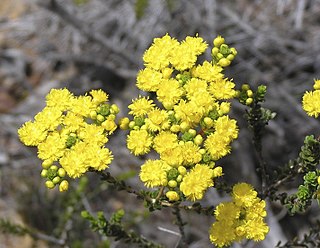
Verticordia serrata is a flowering plant in the myrtle family, Myrtaceae and is endemic to the south-west of Western Australia. It is a spindly or openly branched shrub with hairy, egg-shaped leaves and flowers which are golden at first, then fade to a greyish colour.

Billardiera fusiformis is a species of plant in the family, Pittosporaceae, which is endemic to Western Australia.

Billardiera coriacea is a species of flowering plant in the family Pittosporaceae and is endemic to the south-west of Western Australia. It is a woody scrambler or climber that has more or less oblong leaves, the flowers white to pale yellow and arranged singly or in small groups on short side shoots.

Billardiera drummondii is a species of flowering plant in the family Pittosporaceae and is endemic to the south-west of Western Australia. It is a slender climber that has linear leaves and tiny nodding, blue or mauve flowers arranged in groups of up to three.

Bursaria occidentalis is a species of flowering plant in the family Pittosporaceae and is endemic to Western Australia. It is a spiny tree or shrub with egg-shaped adult leaves, flowers with relatively small, hairy sepals and five spreading creamy-white petals, and inflated capsules.
Olearia incana is a species of flowering plant in the family Asteraceae and is endemic to southern Australia. It is a shrub with narrowly elliptic or wedge-shaped leaves and white and pale yellow, daisy-like inflorescences.
Cryptandra minutifolia is a flowering plant in the family Rhamnaceae and is endemic to the south-west of Western Australia. It is a spreading shrub with oblong to elliptic leaves and clusters of white or pink, tube-shaped flowers.
Pimelea lanata is a species of flowering plant in the family Thymelaeaceae and is endemic to the southwest of Western Australia. It is a shrub with narrowly elliptic leaves and erect clusters of white to deep pink flowers surrounded by 4, mostly green, involucral bracts.

Leucopogon maritimus is a species of flowering plant in the heath family Ericaceae and is endemic to the west coast of Western Australia. It is a low, spreading shrub with hairy young branchlets, erect, narrowly elliptic leaves and erect white, tube-shaped flowers in upper leaf axils or on the ends of branches.
Pimelea sessilis is a species of flowering plant in the family Thymelaeaceae and is endemic to the west of Western Australia. It is an erect shrub with sessile, elliptic leaves, and heads of white or cream coloured flowers surrounded by 4 broadly elliptic involucral bracts.

Billardiera floribunda, commonly known as white-flowered billardiera, is a species of flowering plant in the family Pittosporaceae and is endemic to the south-west of Western Australia. It is a robust twining shrub or climber that has thick, leathery, elliptic leaves and white or pinkish flowers arranged in groups of ten or more.
















